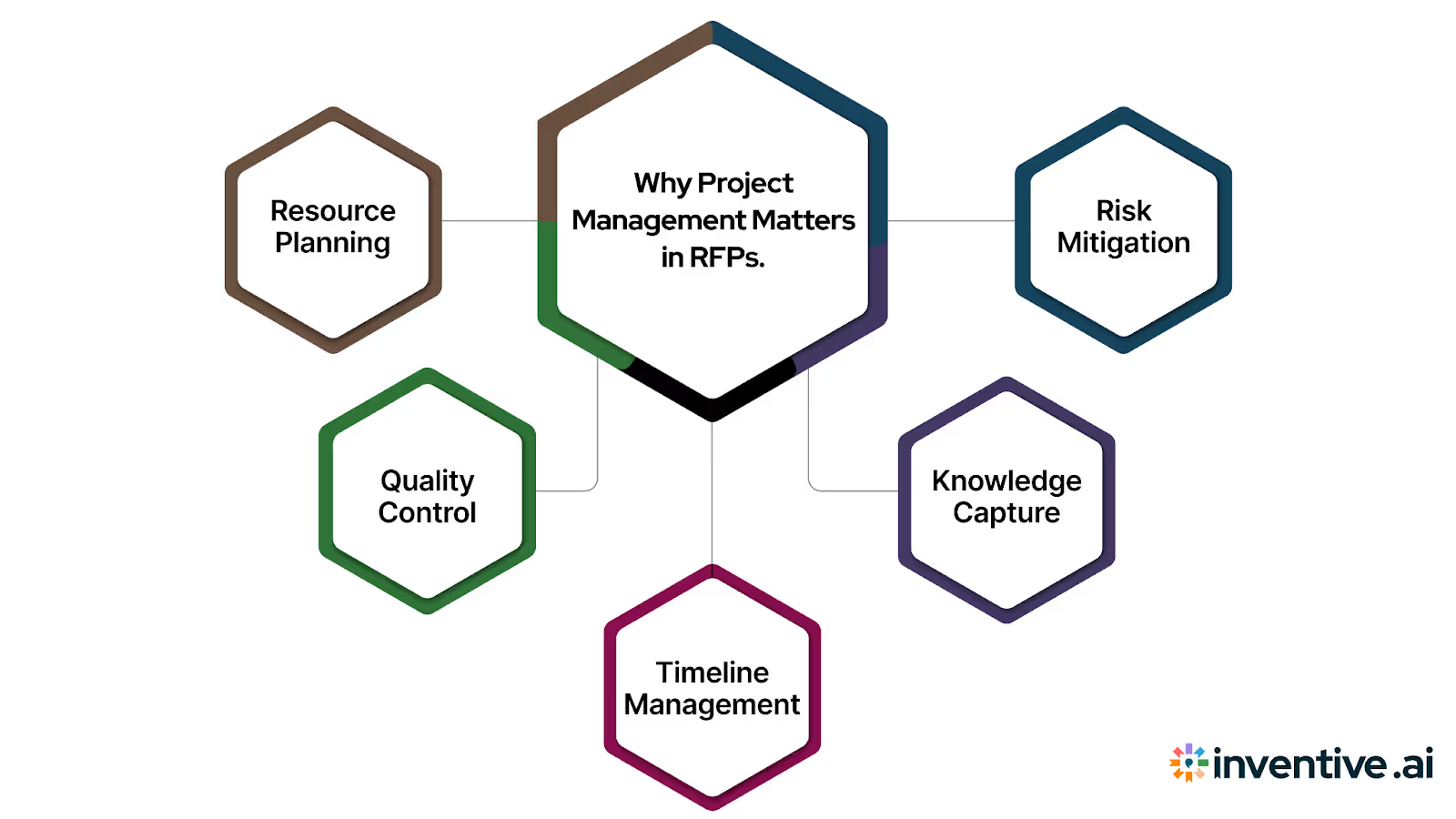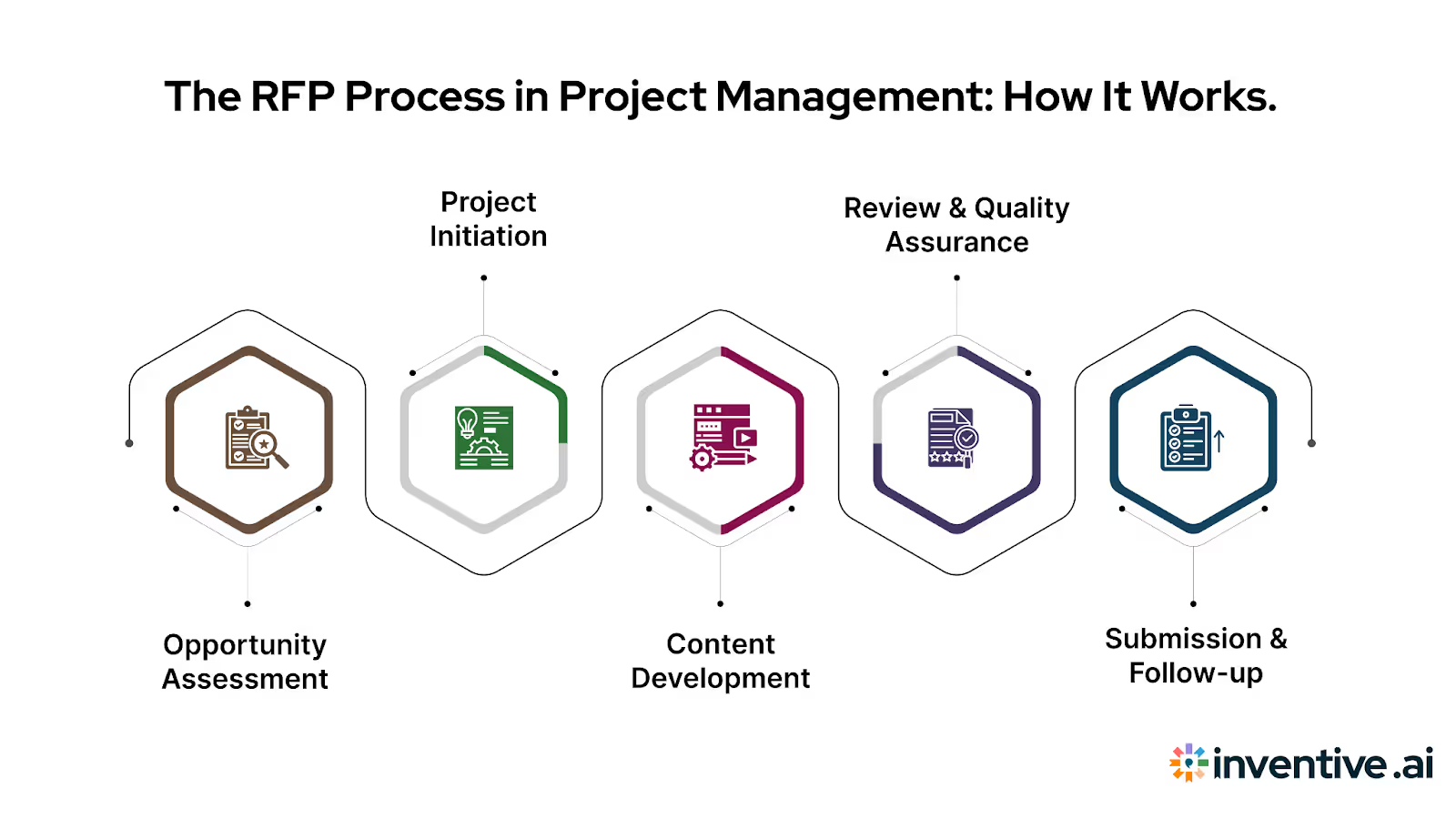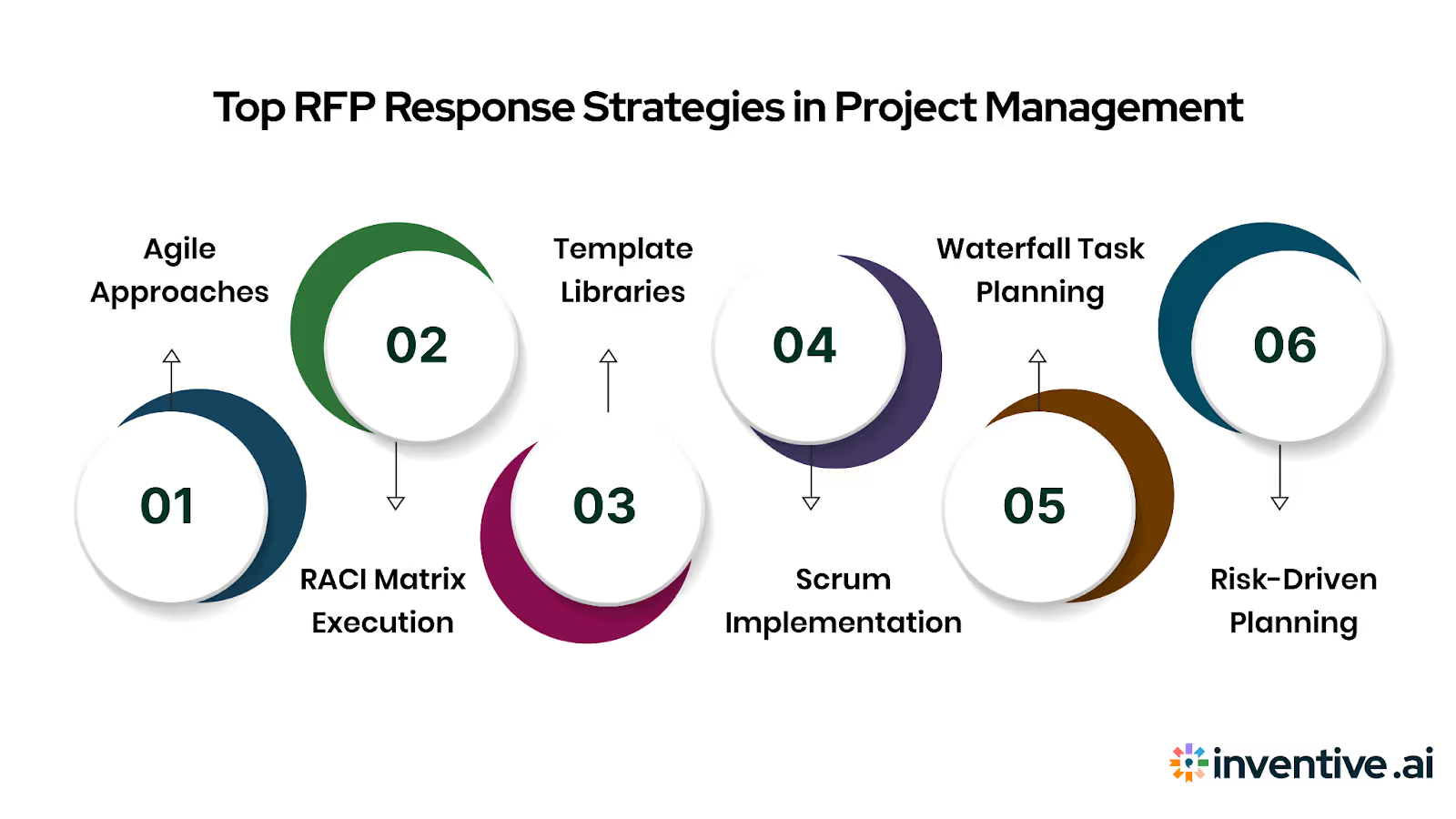Understanding RFP in Project Management, Its Process, and Best Practices
Learn what RFP in project management means and how it exactly works. Explore its common challenges and find out effective best practices to manage it better.

Managing RFP responses can often become chaotic when multiple team members are working on different sections without proper coordination. In fact, a survey revealed that 86% of participants said workplace failures occur due to bad teamwork and communication problems. Most organizations treat RFP responses as urgent tasks that need immediate attention, which leads to missed submission deadlines, inconsistent quality, and stressed teams working under pressure.
However, when you apply project management principles to the RFP process, you can establish a well-organized workflow. Defining clear timelines, responsibilities, and roles for each team member gives you better control over the entire process.
From initial planning to final submission, project management techniques like task allocation, milestone setting, and progress tracking ensure the response is timely, well-coordinated, and of high quality. By managing RFPs as formal projects, you eliminate last-minute rushes, minimize errors, and streamline the process, ultimately increasing the chances of creating a successful proposal. In this guide, you’ll learn everything about project management in RFP and how you can manage it more efficiently.
What is Project Management in RFP?
Project management in RFP refers to the structured approach and application of project management principles to the creation, management, and execution of the RFP process itself. It involves treating the development of the RFP as a formal project, with clearly defined goals, timelines, roles, and responsibilities. This ensures the RFP process is efficient, well-coordinated, and delivers the desired results.
Managing the RFP process like a project involves applying techniques such as scope definition, timeline management, resource allocation, and risk mitigation to ensure the document is comprehensive and meets organizational needs. By treating RFP creation as a project, you enhance the quality of the RFP and improve the chances of selecting the right vendor for the job.
This process involves detailed planning, coordinating with stakeholders, and maintaining clear communication to ensure all parts of the RFP are completed on time and meet the required standards.
Project management in RFP is essential for complex or high-value projects, where the scope, vendor capabilities, and alignment with organizational goals matter as much as the cost. By applying project management principles, organizations can ensure the RFP process is thorough, well-organized, and aligned with strategic objectives, improving the overall success of the project.
How Project Management Principles Apply in RFP Proposals?
Project management offers a structured approach to managing RFPs, ensuring efficiency and improving proposal quality. Here’s how project management principles directly apply to RFPs:
- Clear Structure and Defined Roles: Establishing a clear project structure ensures every team member understands their role. By assigning specific responsibilities (e.g., proposal writer, pricing lead, technical SME), you eliminate ambiguity and avoid duplicated efforts. This fosters accountability and maximizes team productivity.
- Breaking Down Tasks: Instead of tackling the entire proposal at once, break it into smaller tasks such as “research client requirements,” “draft technical response,” and “compile pricing strategy.” Each task is assigned an owner with a defined deadline, ensuring focused effort and timely completion.
- Phases and Checkpoints: Treat each RFP as a mini-project, with clear phases: planning (gathering requirements), execution (drafting sections), and closing (final review). Introduce checkpoints between phases to ensure deliverables are on track and meet client expectations, minimizing the risk of missing critical elements.
- Time-Saving and Stress Reduction: While setting up structured workflows may seem time-consuming initially, it leads to faster, smoother RFP responses. By breaking down the process into manageable tasks and reviewing progress regularly, teams reduce stress, prevent bottlenecks, and improve overall response quality, resulting in higher win rates.
Let’s understand the importance of proposals in project management.
Importance of Project Management In RFP Proposals

Project management uses specific frameworks and methods to track progress, manage resources, and meet timelines. When applied to RFP responses, project management creates clear workflows that prevent common mistakes.
Proper RFP project management creates several advantages for your organization:
- Resource Planning: With precise planning, you can allocate the right resources to each proposal. This reduces burnout and ensures team capacity is properly managed, allowing your team to handle multiple RFPs simultaneously without sacrificing quality or missing deadlines.
- Quality Control: By establishing structured review processes and checkpoints, errors, inconsistencies, and incomplete sections are flagged early. This prevents costly last-minute corrections and enhances the overall quality of your proposals, making them more competitive and aligned with client expectations.
- Timeline Management: Clear milestones and deadlines ensure that every RFP phase is completed methodically. With well-defined timelines, you avoid the stress of rushing through submissions and give ample time for thorough research, drafting, and review, leading to more polished and thoughtful responses.
- Knowledge Capture: Systematic documentation of past proposals creates a library of reusable content. This accelerates future proposal development, reducing time spent on drafting repetitive sections and improving consistency in messaging, which ultimately boosts efficiency and reduces proposal costs.
- Risk Mitigation: Early identification of potential risks—whether it’s resource conflicts, technical challenges, or compliance issues—ensures there is enough time for resolution. By addressing these risks proactively, you can maintain the quality and integrity of your proposals, minimizing the likelihood of missed opportunities or compliance failures.
These benefits compound over time, creating increasingly efficient processes that give you competitive advantages in the marketplace.
Want to learn more about choosing the right tools for your RFP responses? At Inventive AI, we offer an in-depth buying guide for AI RFP solutions that helps vendors evaluate automation platforms for better proposal outcomes.
Knowing why RFP project management matters is great, but it is also important to see how it actually works. Here's the step-by-step process that most teams follow.
How the RFP Proposal Process Works in Project Management?

RFP project management follows a structured workflow that ensures nothing falls through the cracks while maximizing your team's efficiency and proposal quality.
The process begins with opportunity evaluation and continues through final submission with clearly defined phases:
1. Opportunity Assessment
The first step in the process is to evaluate whether the RFP is worth pursuing. Teams assess the opportunity based on company capabilities, win probability, and resource availability. This decision is crucial, as not every RFP is a suitable match.
- Scoring System: A simple scoring system helps determine the alignment of the RFP with the company’s strengths. Factors to consider include past experience with similar projects, the client’s budget, competition, and internal capacity.
- Go/No-Go Decision: If the RFP falls outside your core expertise or your team’s capacity to deliver within the given timeline, it’s smarter to pass. This early assessment saves time and resources, allowing you to focus on opportunities you can realistically wi
2. Project Initiation
Once the decision is made to pursue an RFP, the next step is organizing the project. This involves assigning a dedicated project manager, establishing team roles, and creating a detailed project plan with clear timelines and deliverables.
- Project Manager Role: The project manager is the central hub, responsible for creating a timeline that works backward from the submission deadline. The timeline is broken into phases: research, drafting, review, and final submission.
- Team Responsibilities: The team is divided by expertise. For example, the technical lead handles technical sections, the pricing specialist works on cost details, and the proposal writer crafts the executive summary. Clear task assignments ensure there’s no overlap and that everyone knows their role in the process.
3. Content Development
This phase is where the actual proposal takes shape. Subject matter experts (SMEs) and proposal writers work on their respective sections within established timelines, ensuring that each part addresses client requirements in a customized, professional manner.
- Customization: Instead of using generic content, proposal writers should tailor each section to the client’s needs. For example, if responding to a healthcare RFP, the technical writer should highlight relevant healthcare experience and use industry-specific language.
- Alignment with Client Needs: The pricing section should reflect the client’s budgeting practices and pricing structures. This level of detail demonstrates y
4. Review and Quality Assurance
Quality assurance is a key component in crafting a winning proposal. Proposals typically go through multiple rounds of reviews to ensure they are comprehensive, accurate, and aligned with client needs.
Three Review Rounds:
- The first review focuses on completeness—checking if all sections are included and if each requirement is addressed.
- The second review focuses on technical accuracy, ensuring your proposed solution is viable and effective.
- The final review focuses on formatting, grammar, and compliance with submission guidelines.
Diverse Reviewers: To catch different types of errors, each round should involve different people. For instance, your technical lead might spot missing requirements during a compliance review, while the sales manager may identify inconsistencies between the proposal’s value proposition and pricing.
5. Submission and Follow-up
The final phase ensures everything is submitted correctly and any post-submission activities are accounted for.
- Submission Logistics: The project manager creates a detailed checklist for submission, including file formats, naming conventions, and delivery methods to ensure nothing is missed.
- Post-Submission Activities: Beyond submitting the proposal, the project manager also plans follow-up activities such as preparing for client presentations or negotiation rounds.
- Project Review: After submission, the team conducts a quick review to assess what worked well and areas for improvement. The insights gathered here are documented for future RFPs, continuously improving the process for better outcomes next time.
Each phase includes specific deliverables, quality gates, and approval processes that maintain project momentum while ensuring high standards. Teams that implement winning RFP strategies typically see better outcomes across all phases.
Tired of managing complex RFP workflows manually? Inventiva AI automates every phase from opportunity assessment to final submission. Request a demo to see how our platform can cut your response time by 90%.
Now, every successful RFP process needs someone to guide it from start to finish. The RFP project manager fills this critical role.
RFP Project Manager Roles and Responsibilities
The RFP proposal project manager serves as the central coordinator who ensures all elements of the proposal come together on time and meet quality standards. This role requires both project management expertise and deep understanding of the proposal development process.
Your RFP project manager takes ownership of the entire response lifecycle and coordinates all moving pieces to create winning proposals. Their responsibilities span strategic planning, resource management, and quality control throughout the project duration.
Key responsibilities include comprehensive project oversight across multiple dimensions:
- Project Planning - Develops detailed project schedules, identifies resource requirements, and establishes clear deliverable timelines that align with RFP submission deadlines.
- Team Coordination - Manages cross-functional teams including technical writers, subject matter experts, pricing specialists, and graphic designers to ensure cohesive proposal development.
- Stakeholder Communication - Maintains regular communication with internal stakeholders, client contacts, and team members to address questions, clarify requirements, and manage expectations.
- Risk Management - Identifies potential project risks such as resource conflicts, technical challenges, or timeline pressures and develops mitigation strategies.
- Quality Assurance - Establishes review processes, manages editing cycles, and ensures final proposals meet all RFP requirements and company standards.
- Compliance Oversight - Verifies that all proposal elements comply with RFP instructions, formatting requirements, and submission guidelines.
- Resource Allocation - Balances team workloads, manages competing priorities, and ensures adequate expertise is available for all proposal sections.
The most successful RFP project managers combine strong organizational skills with industry knowledge and the ability to motivate teams under tight deadlines.
Now, understanding the role is important, but you also need effective strategies to make it work properly.
Best Practices & Strategies For RFP Responses In Project Management

Successful RFP project management requires proven strategies that address both tactical execution and strategic positioning. These practices help you create competitive proposals while maintaining efficient workflows and team productivity.
Here are some of the effective project management frameworks that offer specific advantages depending on your RFP complexity and team structure.
1. Agile Response Methods
Agile is a project management approach that breaks work into small, manageable pieces called sprints. Instead of waiting until the end to review your entire proposal, you complete and review each section as you go. This method catches problems early when they're easier to fix.
For example, you might dedicate the first sprint to understanding requirements and creating an outline. The second sprint focuses on technical sections, while the third handles pricing and implementation plans. Each sprint ends with a review to ensure quality before moving forward.
2. RACI Matrix Implementation
RACI is a simple tool that clarifies who does what in any project. It stands for:
- Responsible - who does the work
- Accountable - who owns the outcome
- Consulted - who provides input
- Informed - who needs updates
This removes confusion about roles and prevents important tasks from falling through the cracks.
For example, consider a technical section when responding to an RFP where your engineer is Responsible for writing, the proposal manager is Accountable for final approval, the sales lead is Consulted for customer insights, and the executive team is Informed of progress.
Implementing this framework will allow everyone to know their role in the process and when their input is needed.
3. Template Libraries
Standardized response frameworks and pre-approved content sections speed up writing and ensure consistency across proposals. These templates cover common RFP sections like company background, technical capabilities, and implementation. Instead of starting from scratch, you can customize these templates for each opportunity, saving time and preventing missed elements.
4. Scrum Framework Application
Scrum, an agile methodology using short work cycles (sprints), can be adapted for RFPs by creating mini-sprints for proposal sections. Daily check-ins keep the team aligned, and sprint reviews ensure each section meets quality standards before moving forward.
5. Waterfall Planning for Linear Tasks
Waterfall works for RFP elements with clear dependencies, like completing technical requirements before pricing or content before final formatting. This method ensures a logical flow and prevents rework during the final stages of proposal development.
6. Risk-Based Planning
Risk-based planning involves assessing each opportunity’s complexity and allocating more resources to high-risk areas. Complex sections or new solutions need more time for research and validation, while routine responses require less planning and fewer reviews.
However, even with good strategies, RFP responses face some predictable challenges that are worth considering.
Common Challenges with RFPs
Even with project management principles in place, RFP responses present unique challenges that can derail your efforts if not properly addressed. Understanding these common pitfalls helps you develop strategies to overcome them before they impact your proposals.
The most frequent obstacles include operational and strategic challenges:
- Tight Deadlines - RFPs often have unrealistic timelines that force teams into reactive mode, reducing proposal quality and increasing stress levels across the organization.
- Resource Conflicts - Multiple concurrent RFPs compete for the same subject matter experts and writers, creating bottlenecks and forcing difficult prioritization decisions.
- Content Management - Scattered information across different systems makes it difficult to find relevant past responses, leading to duplicated effort and inconsistent messaging.
- Quality Control - Insufficient review time results in submissions with errors, missing information, or responses that don't fully address buyer requirements.
- Team Coordination - Geographic distribution, different time zones, and varying work styles make it challenging to maintain effective collaboration throughout the proposal process. But implementing proposal workflow optimization strategies can solve many common team coordination issues.
Understanding these challenges allows you to build processes and select tools that specifically address your organization's pain points.
Want to handle these common RFP challenges more effectively? Try our ROI calculator to see how much time and money you could save with better AI-powered RFP management.
The good news is that these traditional challenges now have modern solutions. Let's look at how AI technology is helping RFP teams.
How to Solve RFP Proposal Management Challenges with AI
Traditional RFP management creates bottlenecks that slow down your team and affect proposal quality. AI automation addresses these challenges by handling routine tasks that consume most of your team's time.
The shift toward AI automation is happening faster than most people realize. Studies show that 80% of project management tasks will be handled by AI in the coming years. This means teams that use AI tools now will have a major advantage over those still doing everything manually.
Here's how modern technology solves common RFP challenges:
- Automated Content Discovery - AI systems can instantly find relevant past responses, case studies, and technical specifications from your knowledge base, eliminating hours of manual searching through folders and documents.
- Faster Draft Generation - Instead of starting from scratch, AI can create first drafts by pulling together relevant content pieces and customizing them for specific RFP requirements and client contexts.
- Real-time Collaboration - Cloud-based AI platforms let team members work simultaneously on different sections while maintaining version control and tracking all changes automatically.
- Compliance Checking - AI tools can scan RFP requirements and cross-reference your responses to identify missing information or formatting issues before submission.
- Workflow Automation - Smart systems can assign tasks, send reminders, and track progress across multiple concurrent RFPs without manual project management overhead.
- Content Consistency - AI maintains standardized messaging and branding across all proposals while allowing customization for specific opportunities and client needs.
Now, while exploring RFP, it’s also good to know about its related terminologies like RFI and RFQ. Each one needs a different approach and effort level.
Differences Between RFP, RFI, and RFQ
Understanding the distinctions between RFPs, RFIs, and RFQs helps you apply appropriate project management approaches and allocate resources effectively. Each document type serves different buyer purposes and requires different response strategies.
These three procurement documents represent different stages of the buying process and require tailored project management approaches:
RFIs are exploratory documents that typically require minimal project management since they focus on general information sharing rather than detailed solution development. You can often respond with existing marketing materials and brief capability statements, making them ideal for business development activities.
On the other hand, RFPs are detailed documents that need full project management treatment due to their complexity and competitive nature. These responses require coordinated efforts across multiple teams, extensive customization, and detailed technical development. The project management overhead is justified by the potential contract value and win rate impact.
Whereas, RFQs fall between RFIs and RFPs in complexity, requiring careful pricing analysis and coordination with procurement teams but less technical content development than full proposals.
All these manual processes work. But there’s a better way to automate everything and improve your efficiency by 70%.
How to Make RFP Response Management Easier with Inventive AI?
Traditional RFP project management, while effective, still requires significant manual coordination and time investment.
Modern AI-powered solutions can reduce much of this overhead while improving response quality and team productivity. Inventive AI solves the common challenges that make RFP project management difficult and time-consuming.
Your team deserves tools that handle routine project management tasks automatically, allowing you to focus on strategy, customization, and relationship building rather than administrative coordination.
Inventive AI significantly enhances how proposal teams handle project management RFPs through intelligent automation that works alongside your existing processes:
- 10x Faster Response Generation - Generate accurate first drafts in minutes by automatically pulling relevant project experience, technical capabilities, and team qualifications from your centralized knowledge base.
- Centralized Knowledge Hub - Access all your project case studies, technical documentation, team resumes, and pricing information from one platform, making complex RFP responses much easier to assemble and maintain.
- AI Content Management - Never submit outdated project information or conflicting team qualifications with proactive content flagging that identifies stale or inconsistent information across all your responses.
- Integration Capabilities - Connect with Google Drive, SharePoint, Slack, and your CRM to ensure responses include the most current project information and team capabilities, without manually finding all data.
- Collaborative Workflow - Enable project managers, technical leads, and business development teams to review and refine responses efficiently within tight RFP deadlines through structured review processes.
These capabilities reduce the manual overhead that consumes project manager time while providing better visibility and control. Here’s what others say about our software:
"Inventive has not only helped us save time, but it's also helped us win more. Our win rate increased by more than 50% after implementing Inventive." – Anthony Pukal, Solutions Consultant, Insider
Insider, a global leader in personalized marketing, transformed their RFP workflow from a tedious manual process to an efficient AI-powered system. They cut their response time by 90% and boosted win rates from 30% to 50%. What used to take 4-5 hours for a 100-question RFP now takes just 20-30 minutes. Learn more about their transformation in our detailed Insider case study.
Final Thoughts
Effective RFP project management turns chaotic proposal processes into predictable, efficient workflows that improve both win rates and team satisfaction.
Successful implementation of RFP in project management requires combining proven project management principles with modern tools that automate routine tasks and provide better visibility into your proposal pipeline.
Inventive AI helps you achieve this balance by handling administrative overhead while preserving human focus on strategy and customization.
Ready to see how AI-powered RFP management can improve your win rates by 50% while reducing response times by 90%? Request a demo today.


